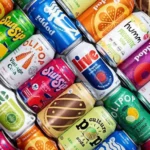
Root beer, a classic American beverage, holds a special place in the hearts of many. With its rich, frothy texture and unique flavor profile, it often evokes memories of summer barbecues, nostalgic soda fountains, and family gatherings. But beyond its delicious taste, root beer has a fascinating history and a variety of intriguing facts that many people may not know. From its famous brands and cultural significance to its unique brewing process and even its alcoholic counterparts, root beer is more than just a soft drink—it’s a cultural icon. In this blog post, we’ll explore 25 interesting facts about root beer that will deepen your appreciation for this beloved beverage and perhaps inspire you to enjoy a refreshing mug of it today!
Origin: Root beer originated in North America during the colonial period, where indigenous peoples used local plants, particularly sassafras and sarsaparilla roots, for their medicinal properties. Early European settlers adopted these practices, creating their own versions of the beverage by combining various roots, herbs, and spices. The drink was initially consumed for its supposed health benefits, often touted as a cure for ailments like stomach issues and fatigue.
First Commercial Production: The first commercially produced root beer was created by Charles Hires in 1876. Hires, a Philadelphia pharmacist, developed a recipe that combined sarsaparilla, vanilla, and other flavorings. He initially marketed it as a tonic and later packaged it as a powdered mix that consumers could rehydrate at home. Hires Root Beer quickly became popular, leading to the establishment of root beer as a staple soft drink in American culture.
Sassafras: Traditional root beer is primarily flavored with sassafras root, which imparts a unique and aromatic taste. Sassafras trees, native to North America, have been used for centuries not only in beverages but also in traditional medicine. The flavor profile of sassafras is often described as sweet and slightly spicy, which is why it became a key ingredient in root beer recipes. However, due to health concerns regarding its safrole content, the use of sassafras in commercial food products has been restricted.
Sassafras Bans: In 1960, the U.S. Food and Drug Administration (FDA) banned the use of sassafras oil in food products after studies indicated that safrole, a compound found in sassafras, could be carcinogenic when consumed in large amounts. This ban led many root beer manufacturers to reformulate their products, often replacing sassafras with artificial flavors or other natural ingredients to maintain the characteristic taste without the associated health risks.
Root Beer Float: The root beer float, a delightful combination of root beer and vanilla ice cream, was popularized in the early 1890s. It is believed that the creation of this iconic dessert drink occurred during a soda fountain boom in America, where ice cream sodas became widely popular. The root beer float combines the creamy texture of ice cream with the fizzy, sweet flavor of root beer, making it a favorite treat, especially during hot summer months.
Non-Alcoholic Beverage: Root beer is classified as a non-alcoholic beverage, distinguishing it from other fermented drinks. While it was originally brewed and fermented, modern root beer is typically carbonated and sweetened without fermentation, resulting in a beverage that contains less than 0.5% alcohol by volume, which is considered non-alcoholic by regulatory standards. This classification has made root beer a popular choice for families and individuals who prefer to avoid alcohol.
Varieties: There are many varieties of root beer available today, ranging from homemade versions to craft and mass-produced brands. Each brand often has its unique recipe, leading to a diverse range of flavors and sweetness levels. Some root beers are brewed using traditional methods, while others are produced using modern techniques. This variety allows consumers to explore different tastes, from the classic flavors of well-known brands to artisanal root beers that incorporate unique ingredients and brewing methods.
Carbonation: Root beer is typically carbonated, which gives it a distinctive fizzy texture that enhances the drinking experience. The carbonation process involves dissolving carbon dioxide gas in the liquid, creating bubbles that provide a refreshing sensation on the palate. This effervescence is a key characteristic of root beer, making it a popular choice for those seeking a bubbly, sweet beverage. The level of carbonation can vary between brands, with some offering a more intense fizz than others.
Sweeteners: Traditional root beer is sweetened with sugar or high fructose corn syrup, contributing to its characteristic sweetness. However, with the rise of health-conscious consumers, many artisanal brands have started using natural sweeteners like honey, agave syrup, or cane sugar. These alternatives can enhance the flavor profile while appealing to those looking for less processed options. The choice of sweetener can significantly influence the overall taste and mouthfeel of the root beer.
Caffeine-Free: Most root beers are caffeine-free, making them a popular choice for individuals looking to avoid caffeine for health or dietary reasons. This lack of caffeine allows root beer to be enjoyed by people of all ages, including children. The absence of caffeine, combined with its sweet and creamy flavor, makes root beer a refreshing alternative to other carbonated beverages that may contain caffeine, such as colas and energy drinks.
Root Beer Barrels: Root beer barrels are a popular candy that mimics the flavor of root beer in a hard candy form. These candies are typically shaped like small barrels and have a sweet, fizzy flavor that closely resembles traditional root beer. They are enjoyed by both children and adults and can often be found in candy stores or during Halloween. The nostalgic taste of root beer barrels evokes memories of the classic beverage, making them a favorite treat for many who grew up enjoying root beer.
Historical Recipes: Early root beer recipes included a variety of roots and herbs, such as sarsaparilla, ginger, and birch. These recipes were often passed down through generations, with families creating their own unique blends based on available ingredients. The diversity of these ingredients contributed to the wide range of flavors found in root beer. In addition to roots, spices like vanilla, cinnamon, and nutmeg were commonly added, creating a complex flavor profile that varied significantly from one household to another.
Root Beer as a Mixer: Root beer is often used as a mixer in cocktails, such as the “root beer float cocktail,” which combines root beer with spirits like vodka or whiskey and ice cream. This creative use of root beer adds a sweet and creamy element to cocktails, making them more appealing to those who enjoy dessert-like drinks. The versatility of root beer as a mixer has led to the creation of various unique cocktails that highlight its rich flavors, further solidifying its place in modern beverage culture.
Popularity: Root beer is particularly popular in the United States and Canada, where it has become a staple soft drink. Its unique flavor and nostalgic associations have contributed to its enduring popularity, especially among those who grew up with it as a childhood favorite. Root beer can often be found at barbecues, parties, and family gatherings, where it is enjoyed by people of all ages. Additionally, its presence in restaurants, diners, and fast-food chains has helped maintain its status as a beloved beverage choice.
Root Beer Day: National Root Beer Day is celebrated on August 6th each year, honoring this iconic beverage and its place in American culture. On this day, root beer enthusiasts often participate in celebrations that may include root beer tastings, floats, and special promotions at restaurants and soda shops. The observance of National Root Beer Day serves as a reminder of the drink’s rich history and its significance in social gatherings, encouraging people to indulge in their favorite root beer varieties.
Brewed vs. Soda: Brewed root beers are made through fermentation, allowing natural carbonation to develop, while soda root beers are carbonated and sweetened without fermentation. Brewed root beers often have a more complex flavor due to the fermentation process, which can enhance the depth of the ingredients used. In contrast, soda root beers are typically more consistent in taste and sweetness, appealing to a broader audience. The distinction between these two types has led to a diverse market, with consumers able to choose based on their preferences for flavor and texture.
Cultural Impact: Root beer has appeared in various movies, television shows, and literature, often as a nostalgic symbol of Americana. Its unique flavor and cultural associations have made it a recognizable element in American pop culture. For instance, root beer is frequently depicted in scenes set in diners or soda fountains, evoking a sense of nostalgia for simpler times. This cultural significance has helped root beer maintain its popularity over the years, as it continues to be celebrated in various forms of media.
Home Brewing: Home brewing kits for root beer are available, allowing enthusiasts to create their own versions of this classic beverage. These kits typically include all the necessary ingredients, such as flavor extracts, sweeteners, and carbonation supplies, enabling individuals to experiment with different flavor combinations and levels of sweetness. Home brewing has become a popular hobby, as it allows people to customize their root beer to suit their personal tastes and share their creations with friends and family.
Regional Variations: Different regions have their own unique recipes and brands of root beer, such as “sarsaparilla” in Australia. These regional variations often reflect local tastes and ingredient availability, resulting in distinct flavor profiles. For example, some areas may emphasize the use of birch or wintergreen, while others might focus on sassafras or sarsaparilla. This diversity has contributed to the rich tapestry of root beer culture, allowing enthusiasts to explore and appreciate the different interpretations of the beverage across the globe.
Historical Significance: Root beer was often consumed as a tonic in the 19th century, believed to have health benefits due to its herbal ingredients. Many early recipes included roots and herbs thought to aid digestion and improve overall health. As a result, root beer was marketed as a healthful beverage, often consumed as a remedy for various ailments. This historical significance contributed to its popularity, as people sought out root beer not only for its taste but also for its perceived medicinal properties. During the late 19th and early 20th centuries, root beer was often found in pharmacies, where it was served as a soda fountain drink, further solidifying its role as a refreshing tonic in American society. The association of root beer with health and wellness has faded over time, but its nostalgic roots continue to resonate with consumers today.
Famous Brands: Root beer is a beloved soft drink in North America, with several iconic brands leading the market. A&W, established in 1919, is one of the oldest and most recognized root beer brands, known for its creamy texture and rich flavor. Barq’s, founded in 1898, has a distinct taste that sets it apart, often described as having a bit more bite due to its higher carbonation levels. Mug, introduced in 1940, is another popular choice, particularly known for its sweet flavor and smooth finish. These brands have become cultural staples, often associated with classic American diners and fast-food chains, contributing to the nostalgic appeal of root beer.
Alcoholic Versions: The emergence of hard root beer has created a new niche within the beverage market. Hard root beer combines the traditional flavors of root beer with alcohol, typically brewed to a similar alcohol content as beer, around 5% to 7% ABV. This innovative twist has gained popularity among consumers looking for a unique alternative to standard alcoholic beverages. Brands like Not Your Father’s Root Beer and Coney Island Brewing Company have capitalized on this trend, offering a variety of flavors that maintain the classic root beer essence while introducing a refreshing alcoholic kick. This category has sparked interest at social gatherings and events, creating a fusion of nostalgia and modern drinking culture.
Color: The deep, dark brown color of root beer is one of its defining characteristics, contributing to its visual appeal. This color arises from the caramelization of sugars during the brewing process, which is often enhanced by the addition of caramel coloring. The rich hue not only signifies the drink’s sweetness but also hints at the complex flavors within. The brewing process can involve various ingredients, including sarsaparilla, vanilla, and spices, which together create the beverage’s signature taste. The dark color of root beer is often associated with warmth and comfort, making it a popular choice for both casual and festive occasions.
Flavor Profile: Root beer boasts a unique and complex flavor profile that distinguishes it from other soft drinks. The primary flavors often include vanilla, which provides a creamy sweetness, and wintergreen, which adds a refreshing minty note. Anise, a spice with a licorice-like flavor, is also a key component, contributing to the beverage’s depth and character. Other flavorings may include sassafras and various spices, creating a harmonious blend that appeals to a wide range of palates. This intricate combination of flavors is what makes root beer a versatile drink, enjoyed on its own or as a complement to various foods, particularly in classic American cuisine.
Cultural Festivals: Root beer has carved out a niche in American culture, inspiring various festivals that celebrate this beloved beverage. Events such as root beer floats and tastings often feature local and national brands, allowing enthusiasts to sample a variety of flavors and styles. Some festivals even host competitions where participants can showcase their homemade root beer recipes, fostering a sense of community and creativity. These gatherings often include live music, food vendors, and family-friendly activities, making them popular destinations for people of all ages. The cultural significance of root beer is highlighted at these festivals, where the drink is not just a beverage but a symbol of nostalgia and enjoyment in social settings.
FAQs about Root Beer
1. What is Root Beer?
- Root Beer is a sweet, carbonated, and typically non-alcoholic beverage.
- It’s a uniquely American creation with origins tracing back to the 18th century.
- Historically, it was often made from the roots and bark of various plants, giving it a slightly herbal and spicy flavor.
- Modern root beer primarily uses artificial flavorings to achieve that distinctive taste.
2. What are the Common Flavors in Root Beer?
- While the exact blend varies by brand, common flavor components include:
- Sassafras: (Historically used, now often synthetically replicated)
- Wintergreen
- Anise
- Ginger
- Licorice
- Vanilla
- Spices like cloves and cinnamon
3. Is Root Beer Alcoholic?
- Most commercially available root beers are non-alcoholic.
- However: There are some alcoholic root beers available, often as craft brews or specialty products.
4. What is a Root Beer Float?
- A Root Beer Float is a classic American treat.
- It’s made by pouring root beer over a scoop of vanilla ice cream.
- The ice cream melts slightly, creating a delightful foamy and bubbly concoction.
5. How is Root Beer Made?
- Modern production: Typically involves:
- Flavoring concentrates: Combining various synthetic and natural flavorings.
- Sweeteners: Often high fructose corn syrup or sugar.
- Carbonation: Adding carbon dioxide gas to create the fizz.
- Water: Combining all ingredients and bottling or canning.
6. Is Root Beer Healthy?
- Generally considered an occasional treat.
- High in sugar: Can contribute to weight gain and other health concerns if consumed excessively.
- Some brands may contain artificial colors and preservatives.
7. Where Can I Buy Root Beer?
- Widely available:
- Grocery stores
- Convenience stores
- Drugstores
- Restaurants
8. What are Some Popular Root Beer Brands?
- A&W
- Barq’s
- Mug Root Beer
- IBC Root Beer
- Virgil’s (Craft root beer with unique flavor profiles)
9. Can I Make Root Beer at Home?
- Yes! There are various home brewing kits and recipes available online.
- Homemade root beer often involves using extracts, spices, and sugar to create a unique flavor.
10. What are Some Interesting Facts About Root Beer?
- Early root beers were often home remedies.
- Root beer was served at the 1876 Philadelphia Centennial Exhibition.
- It’s a popular flavor for candies and other treats.









